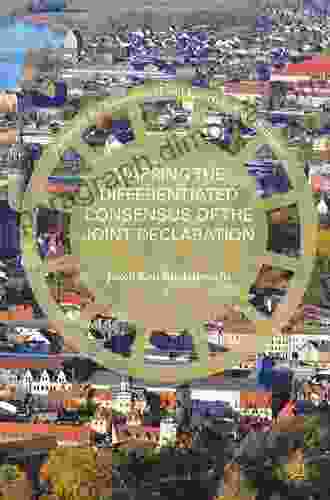Mapping the Differentiated Consensus of the Joint Declaration Pathways for Peace

In the pursuit of peace in conflict-affected regions, the Joint Declaration Pathways for Peace (JDPP) has emerged as a landmark framework to guide peacebuilding processes. This article delves into the intricacies of the JDPP, illuminating its core concepts, examining the diverse perspectives it encompasses, and assessing its implications for peacebuilding practices.
5 out of 5
| Language | : | English |
| Item Weight | : | 4.6 ounces |
| File size | : | 1876 KB |
| Text-to-Speech | : | Enabled |
| Enhanced typesetting | : | Enabled |
| Print length | : | 294 pages |
| Screen Reader | : | Supported |
Conceptual Foundations of the JDPP
The JDPP is grounded on the recognition of differentiated consensus, a nuanced approach to peacebuilding that acknowledges the multiplicity of viewpoints and interests within conflict-affected societies. This concept emphasizes the need to foster dialogue and collaboration among all stakeholders, including conflict parties, civil society organizations, and international actors. By engaging with these diverse perspectives, the JDPP aims to create an inclusive and participatory peacebuilding process that is rooted in the realities and aspirations of the affected communities.
The JDPP outlines specific pathways for achieving peace, including: dialogue and negotiation, mediation, confidence-building measures, and peace agreements. It is important to note that these pathways are not mutually exclusive; rather, they can be tailored and combined to suit the unique circumstances of each conflict.
Diverse Perspectives on the JDPP
While the JDPP serves as a guiding framework, its interpretation and implementation can vary depending on the perspective of the actors involved.
- Conflict Parties: Conflict parties may view the JDPP as an opportunity to engage in dialogue and explore peaceful resolutions to the conflict. However, they may also be skeptical of the process if they perceive it as a threat to their power or legitimacy.
- Civil Society Organizations: Civil society organizations often embrace the JDPP's emphasis on inclusivity and participatory peacebuilding. They see it as an avenue to advocate for the needs and perspectives of marginalized communities.
- International Actors: International actors, such as the United Nations and regional organizations, play a crucial role in supporting the implementation of the JDPP. They can provide expertise, resources, and mediation services to facilitate dialogue and build confidence between conflict parties.
Implications for Peacebuilding Practices
The JDPP has significant implications for peacebuilding practices, emphasizing several key considerations:
- Inclusivity: Peacebuilding processes must be inclusive of all stakeholders, representing the diverse perspectives and interests within the affected communities.
- Dialogue: Dialogue and negotiation are essential tools for building understanding, bridging differences, and finding common ground.
- Tailored Approaches: Peacebuilding strategies should be tailored to the specific context of each conflict, recognizing the unique challenges and opportunities.
- Monitoring and Evaluation: Regular monitoring and evaluation are crucial to assess the progress and impact of peacebuilding efforts.
The Joint Declaration Pathways for Peace provides a valuable framework for navigating the complex challenges of peacebuilding. By embracing differentiated consensus, engaging with diverse perspectives, and implementing tailored strategies, peacebuilders can strive to create sustainable and inclusive peace agreements. This article has shed light on the key concepts, perspectives, and implications of the JDPP, offering insights for practitioners, policymakers, and researchers alike.
5 out of 5
| Language | : | English |
| Item Weight | : | 4.6 ounces |
| File size | : | 1876 KB |
| Text-to-Speech | : | Enabled |
| Enhanced typesetting | : | Enabled |
| Print length | : | 294 pages |
| Screen Reader | : | Supported |
Do you want to contribute by writing guest posts on this blog?
Please contact us and send us a resume of previous articles that you have written.
 Book
Book Novel
Novel Page
Page Chapter
Chapter Text
Text Story
Story Genre
Genre Reader
Reader Library
Library Paperback
Paperback E-book
E-book Magazine
Magazine Newspaper
Newspaper Paragraph
Paragraph Sentence
Sentence Bookmark
Bookmark Shelf
Shelf Glossary
Glossary Bibliography
Bibliography Foreword
Foreword Preface
Preface Synopsis
Synopsis Annotation
Annotation Footnote
Footnote Manuscript
Manuscript Scroll
Scroll Codex
Codex Tome
Tome Bestseller
Bestseller Classics
Classics Library card
Library card Narrative
Narrative Biography
Biography Autobiography
Autobiography Memoir
Memoir Reference
Reference Encyclopedia
Encyclopedia Paul Getty
Paul Getty John Grasso
John Grasso Jacquie Abram
Jacquie Abram Kymberli Hagelberg
Kymberli Hagelberg Jan Kostura
Jan Kostura Jacqui Castle
Jacqui Castle James Wilson
James Wilson J N Paquet
J N Paquet James Scanlan
James Scanlan Joshua A Braun
Joshua A Braun Per F Dahl
Per F Dahl Rob Gibson
Rob Gibson Jack Hawn
Jack Hawn Nick Cain
Nick Cain Janice Beck Stock
Janice Beck Stock Rob Atherton
Rob Atherton John Donne
John Donne J H Mori
J H Mori James Lafond
James Lafond Miles Howard
Miles Howard
Light bulbAdvertise smarter! Our strategic ad space ensures maximum exposure. Reserve your spot today!

 Allen GinsbergBCI Equity Research Analysis: The Ultimate Guide to Unlocking High-Return...
Allen GinsbergBCI Equity Research Analysis: The Ultimate Guide to Unlocking High-Return... Vic ParkerFollow ·12.9k
Vic ParkerFollow ·12.9k Roger TurnerFollow ·6.9k
Roger TurnerFollow ·6.9k Kyle PowellFollow ·14.5k
Kyle PowellFollow ·14.5k Rick NelsonFollow ·12.9k
Rick NelsonFollow ·12.9k Michael ChabonFollow ·19.2k
Michael ChabonFollow ·19.2k Edison MitchellFollow ·2k
Edison MitchellFollow ·2k Simon MitchellFollow ·8.1k
Simon MitchellFollow ·8.1k Benji PowellFollow ·6.1k
Benji PowellFollow ·6.1k

 William Golding
William GoldingWhere Dreams Descend: A Literary Gateway to a Kingdom of...
Prepare yourself for a...

 Joseph Conrad
Joseph ConradAmy Tan: Asian Americans of Achievement
Amy Tan is an...

 Fredrick Cox
Fredrick CoxAn Acorn Frog and Dog: An Unforgettable Adventure for...
Embark on an enchanting journey with "An...

 Robert Reed
Robert ReedAnna Sui: An Inspiring Asian American Role Model
Anna Sui is a...

 Jeremy Cook
Jeremy CookGrowing Up in Slavery: An Unforgettable and Harrowing...
A Window into a Forgotten...
5 out of 5
| Language | : | English |
| Item Weight | : | 4.6 ounces |
| File size | : | 1876 KB |
| Text-to-Speech | : | Enabled |
| Enhanced typesetting | : | Enabled |
| Print length | : | 294 pages |
| Screen Reader | : | Supported |












